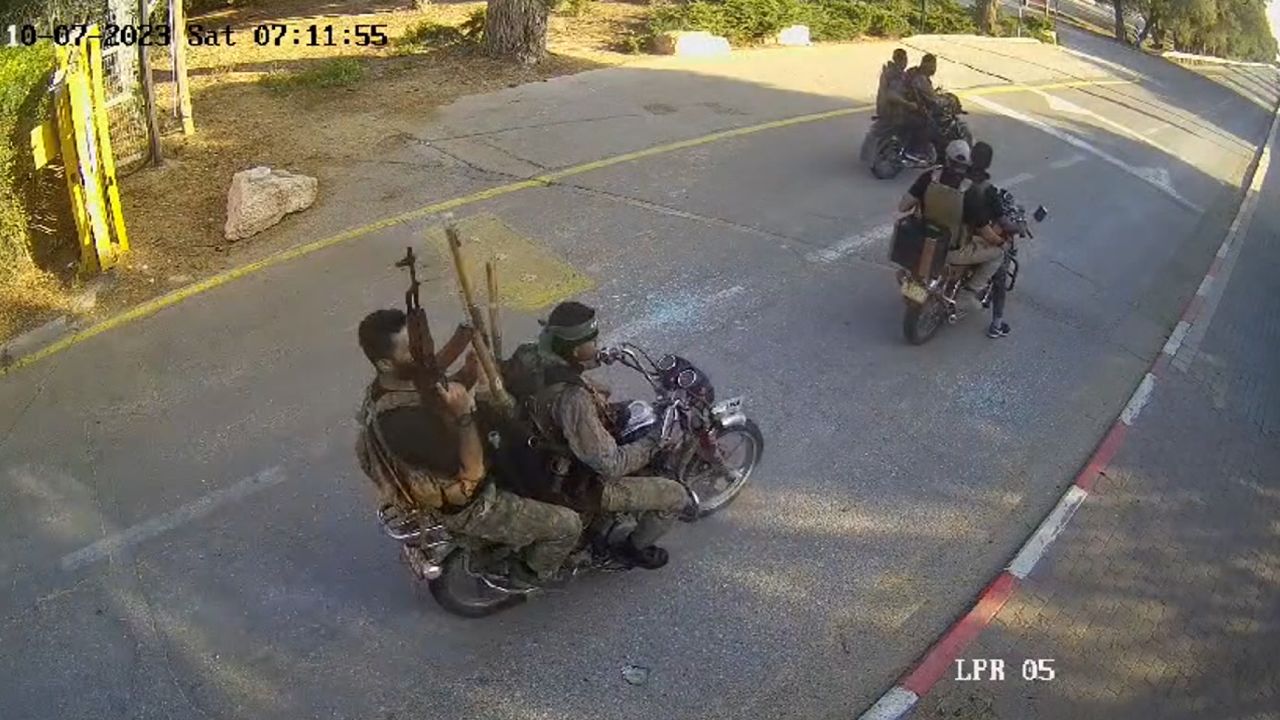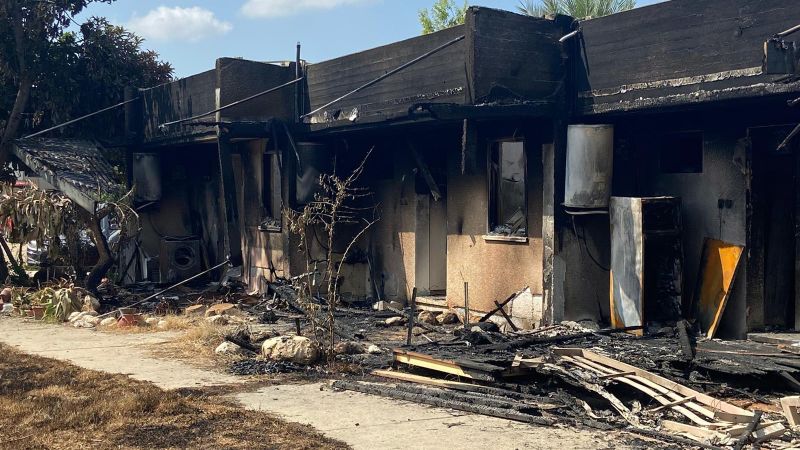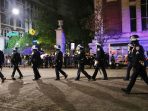Kfar Aza, Israel
CNN
—
Bodies of Israeli residents and Palestinian militants lay outside of burned-out homes in the Israeli kibbutz Kfar Aza on Tuesday, days after Hamas launched a large-scale surprise assault on Israel, sending heavily armed fighters pouring across the border from Gaza and rampaging through rural communities.
The Israel Defense Forces (IDF) took a CNN team and other foreign press to the site, as they went house to house collecting the dead in body bags and loading them onto a truck. Among those killed in Kfar Aza were children, women and elderly, the IDF said.
The horrifying details of attacks on border communities are just beginning to come to light. Kfar Aza is one of the several kibbutzim, small farming enclaves, that bore the brunt of Hamas’ ground assault on Saturday.
The kibbutzim go back to the time of the founding of Israel, when small groups of people set up communities based on the idea of communal living. About 125,000 people live across approximately 250 kibbutzim in Israel, according to the Jewish Agency for Israel. For many, they were symbols of good life and safety.
A number of kibbutzim and towns were targeted in the first wave of Hamas’ assault, including Kfar Aza, Be’eri, Ofakim, Sderot, Yad Mordechai, Yated, Kissufim and Urim. Revelers at a music festival held in the desert outside of Be’eri were also gunned down and taken hostage.
At least 1,200 people have died in Israel since the conflict erupted, according to public broadcaster Kan.
Israel has retaliated by pounding Gaza with a relentless aerial campaign that has flattened homes, schools, medical institutions and government buildings in the besieged strip.
The death toll in Gaza has risen to 900, including 260 children and 230 women, according to the Palestinian Ministry of Health, with another 4,500 wounded.
In pictures: The deadly clashes in Israel and Gaza
Hamas militants carried out a “massacre” in Kfar Aza during their attacks over the weekend, in which women, children, toddlers and elderly were “brutally butchered in an ISIS way of action,” the Israel Defense Forces (IDF) told CNN on Tuesday.
The IDF said it cannot confirm the number of people killed there and would not go into details how the people were killed.
Houses in Kfar Aza were ransacked and set ablaze. Overturned mattresses, destroyed furniture, broken trinkets and unexploded grenades lay strewn across the grounds, along with dead bodies – a window into the scale of devastation wrought by Hamas in this area.
“I’ve never seen anything like this in my career, never in 40 years of service this something I never imagined,” Maj. Gen. Itai Veruv told CNN on Tuesday, just a few hours after Israeli troops secured the Kfar Aza kibbutz from Hamas militants.
Veruv said his soldiers spent “about 48 hours” fighting “waves and waves of terrorists” on roads and in neighboring communities. He said he had started fighting militants in the Yakhini moshav (community) on Saturday, moving then “from battle to battle,” on the road to Sderot, before reaaching the Be’eri kibbutz on Monday evening.
“I saw hundreds of terrorists in full armor, full gear, with all the equipment and all the ability to make a massacre, go from apartment to apartment, from room to room and kill babies, mothers, fathers in their bedrooms,” Veruv said.

Veruv said he had been retired from the IDF for eight years before rushing to join the counter-offensive efforts on Saturday morning, but nothing could have prepared him for what he saw.
“I have heard during my childhood about the pogroms in Europe, the Holocaust, of course. All my family came from Europe, they are survivors. But I never thought I would see…things like that,” he said about the scene in Kfar Aza.
More than 100 bodies were found in Be’eri on Monday. Civilians were killed and taken hostage in the kibbutz, which is home to about 1,000 residents, according to Israeli authorities and videos obtained and authenticated by CNN.
Heavily armed militants arrived in Be’eri on motorbikes around 7 a.m., just half an hour after they breached the typically high-tech, tightly guarded border wall between Gaza and Israel, videos show.

A bloodbath followed.
Footage shows militants pulling three bodies out of a car, before stealing the vehicle and driving north. The video, which first surfaced on Telegram, was taken by a surveillance camera in Be’eri. CNN has geolocated the video to an intersection in the northeastern part of the kibbutz.
Another video shows armed militants taking five Israeli civilians captive, with the bodies of four later seen lying on the ground nearby in another video verified by CNN.
Terrified residents told Israel’s Channel 12 television station that assailants went door to door, trying to break into their homes.
Of at least 107 bodies discovered in the aftermath, most were of local residents of the kibbutz, though some were of Israeli security forces, a search and rescue spokesperson told CNN.
The IDF acknowledged on Monday that Be’eri was “very badly hit.”
“We thought we would need more rooms (to house the evacuees). We didn’t need all the rooms,” said IDF spokesperson Lt. Col. Richard Hecht.
The attack on Be’eri came around the same time as Hamas militants descended upon a music festival, known as Nova, just three miles south, shooting revelers at point-blank range and looting their belongings.
More than 260 bodies were later found at the festival site, with many attendees believed to have been captured and brought to Gaza, sparking a desperate search by family members and foreign governments.
In Urim, a kibbutz 10 miles south of Be’eri, residents awoke at 6:30 a.m. on Saturday to the sound of sirens and rushed to above-ground bomb shelters. The routine reaction to incoming rocket fire soon became more concerning, as the sirens continued sounding throughout the morning and they went in and out of hiding.
Members of the community, which is not far from where militants rampaged the Nova music festival, began to see reports of Hamas attacks on kibbutzim and towns near the border.
Wayne Lucas, a Virginia native who serves as a “lone soldier” in the IDF and lives in Urim, said that he spoke to several friends “who were hiding in their houses from the terrorists,” and, as the day progressed, he heard of attacks closer to home.
“We learned that someone from our kibbutz who I know very well, whose family also hosts lone soldiers was shot at the junction outside our kibbutz near the gas station. Luckily, he was only shot in the hand,” he told CNN.
There are over 7,000 lone soldiers currently serving in the IDF, according to the Lone Soldier Center, many new immigrants or volunteers from Jewish communities abroad.
On Sunday, after a restless night, residents in Urim heard gunshots close by.
“Shortly after 1:30 in the afternoon, we heard gunshots coming from inside the kibbutz. We all dropped everything. We ran as fast as we could to the shelters. We locked the doors, and we were barricading ourselves inside. People had knives and random things to use as weapons,” Lucas said.
All Israeli buildings erected after 1993 are required to have bomb shelters – reinforced rooms with concrete walls and heavy steel doors. But these safe rooms are designed to withstand a rocket attack, not an armed incursion. The doors are heavy, but they don’t have locks – they are not supposed to be lockable, for safety reasons.
Another soldier who lives in Urim said he heard gunfire but couldn’t make it to the shelter in time. “I heard a round of six bullets being shot right outside my room. I cannot tell you how scared I was. I didn’t know what I needed to do first: hide, lock my door, find a weapon, run to the nearest shelter?” the soldier, who asked not to be named, told CNN. “There was nowhere good to hide, and I ended up hiding in my closet.”
The soldier and Lucas said that when they were given the all-clear, an Israeli army unit was outside and had apprehended several militants who had tried to storm the kibbutz.
CNN’s Martin Goillandeau, Paul P. Murphy, Gianluca Mezzofiore, Kathleen Magramo and Ruba Alhenawi contributed reporting.
Sumber: www.cnn.com





